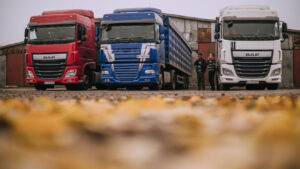
The Food and Agriculture Organization of the United Nations (FAO) has transferred modern technical equipment to the Institute of Fisheries, Marine Ecology and Oceanography (IRGEMO), according to the press service of the State Fisheries Agency.
“The development and systematic updating of the material and technical base of scientific institutions is a key condition for high-quality research in the field of fisheries. Modern equipment expands the possibilities for field and laboratory monitoring of aquatic biological resources, increases the accuracy of data collection and analysis, and ensures their practical use in management decision-making. This forms the basis for effective and long-term state policy in the field of conservation and rational use of aquatic ecosystems,” emphasized Deputy Minister of Economy, Environment, and Agriculture Taras Vysotsky, whose words are quoted in the report.
During the meeting, the head of the State Fisheries Agency, Ihor Klymenok, presented the features of the reform of the fisheries sector, the status of joint projects, and outlined areas for further cooperation.
The list of technical equipment transferred to the scientific institution for conducting ichthyological research and assessing aquatic biological resources includes two vehicles needed for scientific teams to conduct field work, two boats with a trailer for their transportation, six microscopes, sets of water analyzers for hydrological, hydrochemical, and ecological research, and a portable echo sounder with multi-frequency sensors, a control station, and software.
“Assistance from international partners is critical to strengthening the scientific capacity of the industry in the current environment,” said the head of the State Fisheries Agency, thanking the FAO for its systematic support of Ukraine’s fisheries sector.

December is traditionally one of the most successful months for Ukrainian cheese producers in terms of sales, but in 2025, not all companies in the industry will be able to boast positive dynamics, according to the analytical publication Infagro.
“Although cheese consumption in Ukraine has likely increased, the main growth has been in imported products,” analysts noted, adding that this is due to the significant price advantage of European cheeses.
Importers purchase products in EU countries at a significantly lower price than they are produced in Ukraine, and experts predict that their cost will not increase in the near future.
The agency noted that cheese imports to Ukraine increased in November, although not as much as predicted. Imports were up 10% compared to October. Imports of “white” cheeses increased by 4%. At the same time, imports of processed cheeses decreased by 18%.
Experts hope that imports will grow more actively in December, as was the case last year.
They recalled that cheese consumption in Ukraine has not yet returned to pre-war levels, which complicates competition for domestic producers. According to analysts’ estimates, in 2025, sales of semi-hard cheeses on the domestic market will be 17% lower than in 2021. At the same time, the average Ukrainian, as before the war, consumes about 2 kg of such cheese per year, and about a quarter of this volume is European-made cheese.
“Exports of semi-hard cheeses from Ukraine remain half the size of imports. At the same time, export prices exceed import prices. In November, exports of processed cheese products also fell sharply to their lowest level since the beginning of the year,” Infagro reported.

Imports of trucks to Ukraine in January-November 2025 increased by 7.5% in monetary terms compared to the same period in 2024, reaching $897.2 million, according to statistics from the State Customs Service.
According to the published data, the growth rate of imports of these vehicles has slowed down again, in particular, over 10 months it amounted to 8% compared to the same period in 2024.
In particular, in November, truck imports increased by 2.2% compared to November 2024, to $77.5 million, which, however, is 2% less than in October 2025.
The largest number of trucks in 11 months was imported from Poland – $155.7 million (8% less than last year), France – $151.2 million (45.6% more), and the United States – $105 million (16.5% more).
Imports of trucks from all other countries in January-November increased by 3% to $485.3 million.
At the same time, according to statistics, Ukraine exported only $6 million worth of trucks in 11 months, mainly to Turkey (64.3% of exports), Romania, and Moldova, while a year earlier, exports were even more insignificant ($2.9 million), mainly to Moldova, Poland, and Kazakhstan.
As reported, in 2024, imports of trucks to Ukraine in monetary terms increased by 30% compared to 2023, to $947.84 million, with most of them imported from Poland (almost 20%).

According to the Serbian Economist, the investment company of Jared Kushner, son-in-law of US President Donald Trump, Affinity Partners, has withdrawn from the project to build a hotel and business complex on the site of the former building of the General Staff of the Yugoslav Army in the center of Belgrade.
According to Radio Liberty (Balkan service), the company has withdrawn its application for the project, which envisioned the construction of a luxury complex on the site of the General Staff buildings destroyed during NATO bombing raids in 1999.
According to a spokesman for Affinity Partners, the decision was made “out of respect for the citizens of Serbia and Belgrade,” as large projects “should unite, not divide” society.
The announcement of the company’s withdrawal from the project came against the background of the fact that on the same day, the Serbian Prosecutor’s Office for Combating Organized Crime filed an indictment against Culture Minister Nikola Selakovic and a number of officials. They are accused of abuse of power and falsification of documentation when the General Staff complex was stripped of its status of protected cultural heritage, which opened the way for commercial development of the site.
Kushner’s project during the year caused mass protests of the opposition, student and urban protection initiatives, which insisted on the preservation and restoration of the complex as an important monument of modernist architecture and a memorial site associated with the victims of the 1999 bombings. Activists called the investor’s rejection an “important victory,” but warned that the General Staff remains at risk of status changes and possible demolition in favor of other development projects.
The Serbian government and presidential administration had not commented on the information about Affinity Partners’ withdrawal from the project at the time of publication of the Radio Liberty piece.
Affinity Partners is a private investment company of Jared Kushner, created after his departure from Donald Trump’s administration and working with the capital of Middle Eastern and other institutional investors. In Serbia, the redevelopment project of the General Staff complex was realized through affiliated structures (including Atlantic Incubation Partners / Affinity Global Development) and envisioned an investment of about $500 million, a 99-year lease on the site and a profit share for the state of Serbia of about 22%, the New York Times and other media reported earlier.
https://t.me/relocationrs/1947

In January-November 2025, Ukraine reduced imports of nickel and nickel products by 0.3% compared to the same period in 2024, to $23.592 million. In November, imports of nickel and nickel products amounted to $2.546 million.
Exports of nickel and nickel products in January-November 2025 amounted to $1.245 million (in November — $113,000) compared to $585,000 in the first 11 months of 2024.
In addition, Ukraine increased imports of nickel and nickel products by 73.7% in 2024 compared to 2023, to $26.730 million.
At the same time, in 2023, it reduced imports of nickel and nickel products by 74.2% compared to 2022, to $15.391 million.
Exports of nickel and nickel products in 2024 amounted to $602,000, while in 2023 they amounted to $532,000, and in 2022 — $1.268 million.
Nickel is used in the production of stainless steel and for nickel plating. Nickel is also used in the production of batteries, in powder metallurgy, and in chemical reagents.

American payment system operator PayPal Holdings Inc. has applied to establish a bank. According to a PayPal press release, the application has been submitted to the Utah Department of Financial Institutions and the Federal Deposit Insurance Corporation (FDIC) for review.
The company expects PayPal Bank to be able to provide credit solutions to small businesses in the US, as well as offer interest-bearing savings accounts to consumers.
“Since 2013, the company has provided access to more than $30 billion in financing in the form of loans and working capital to businesses around the world,” the press release said. “The creation of PayPal Bank will allow us to offer credit solutions to businesses more effectively.”
PayPal Bank also plans to participate in the card business in the US.
The bank will be headed by Mara McNeill, who has 25 years of experience in the financial services industry. Prior to joining PayPal, she was president and CEO of Toyota Financial Savings Bank.
PayPal shares have fallen 29% since the beginning of this year.